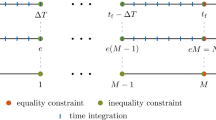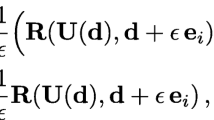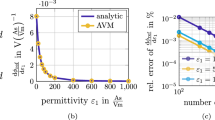Abstract
In optimization of transient problems, a robust, stable, and efficient numerical scheme for time integration is of much importance. Recently, the mixed Lagrangian formalism (MLF) has been proposed for the time integration of transient problems. MLF leads to an optimization problem for the computation of the state variables in each time step. It has shown a robust behavior, even in the presence of sharp gradients of the state variables in time. It has also been applied to a large variety of transient problems, including structural dynamics, multi-physics, and coupled problems, where it has shown its stability, robustness, and computational efficiency. Albeit the clear advantages of MLF, due to its nature, sensitivity analysis for responses of interest is challenging. However, adopting MLF within a first-order optimization framework while efficiently deriving its sensitivities will result in an efficient computational framework for the optimization of transient problems, while avoiding convergence issues in the time integration. This is done here by first reformulating the time integration scheme so as to enable working with more convenient functions. Then, for the sake of sensitivity analysis only, KKT conditions are formulated to replace the optimization problem of MLF in each time step. Finally, the sensitivity analysis is performed based on these KKT conditions. The sensitivity analysis is utilized here for the optimization of the dynamic response of a structure with tension-only yielding elements using viscous dampers.








Similar content being viewed by others
References
Alberdi R, Zhang G, Li L, Khandelwal K (2018) A unified framework for nonlinear pathdependent sensitivity analysis in topology optimization. Int J Numer Methods Eng 115.1:1–56
Andreassen E, Jensen JS (2014) Topology optimization of periodic microstructures for enhanced dynamic properties of viscoelastic composite materials. Struct Multidiscip Optim 49.5:695–705
Andreasen CS, Sigmund O (2013) Topology optimization of fluid–structure–interaction problems in poroelasticity. Comput Methods Appl Mech Eng 258:55–62
Apostolakis G, Dargush G (2011) Mixed Lagrangian formulation for linear thermoelastic response of structures. J Eng Mech 138.5:508–518
Apostolakis G, Dargush G (2013) Variational methods in irreversible thermoelasticity: theoretical developments and minimum principles for the discrete form. Acta Mech 224.9:2065–2088
Behrou R, Guest JK (2017) Topology optimization for transient response of structures subjected to dynamic loads. In: 18th AIAA/ISSMO multidisciplinary analysis and optimization conference, pp 3657
Bogomolny M, Amir O (2012) Conceptual design of reinforced concrete structures using topology optimization with elastoplastic material modeling. Int J Numer Methods Eng 90.13:1578–1597
Dahl J, Jensen JS, Sigmund O (2008) Topology optimization for transient wave propagation problems in one dimension. Struct Multidiscip Optim 36.6:585–595
Daniel Y, Lavan O (2014) Gradient based optimal seismic retrofitting of 3D irregular buildings using multiple tuned mass dampers. Comput Struct 139:84–97
Deaton JD, Grandhi RV (2014) A survey of structural and multidisciplinary continuum topology optimization: post 2000. Struct Multidiscip Optim 49.1:1–38
Deng Y, Liu Z, Zhang P, Liu Y, Wu Y (2011) Topology optimization of unsteady incompressible Navier–Stokes flows. J Comput Phys 230.17:6688–6708
Domschke P, Geißler B, Kolb O, Lang J, Martin A, Morsi A (2011) Combination of nonlinear and linear optimization of transient gas networks. INFORMS J Comput 23.4:605–617
Fritzen F, Xia L, Leuschner M, Breitkopf P (2016) Topology optimization of multiscale elastoviscoplastic structures. Int J Numer Methods Eng 106.6:430–453
Gunzburger MD (1999) Sensitivities, adjoints and flow optimization. Int J Numer Methods Fluids 31.1:53–78
Ivarsson N, Wallin M, Tortorelli D (2018) Topology optimization of finite strain viscoplastic systems under transient loads. Int J Numer Methods Eng 114.13:1351–1367
James KA, Waisman H (2015) Topology optimization of structures under variable loading using a damage superposition approach. Int J Numer Methods Eng 101.5:375–406
Jensen HA (2005) Design and sensitivity analysis of dynamical systems subjected to stochastic loading. Comput Struct 83.14:1062–1075
Jensen JS, Sigmund O (2011) Topology optimization for nano–photonics. Laser Photon Rev 5.2:308–321
Jensen JS, Nakshatrala PB, Tortorelli D (2014) On the consistency of adjoint sensitivity analysis for structural optimization of linear dynamic problems. Struct Multidiscip Optim 49.5:831–837
Kang B-S, Park G-J, Arora JS (2006) A review of optimization of structures subjected to transient loads. Struct Multidiscip Optim 31.2:81–95
Kato J, Hoshiba H, Takase S, Terada K, Kyoya T (2015) Analytical sensitivity in topology optimization for elastoplastic composites. Struct Multidiscip Optim 52.3:507–526
Lavan O (2010) Dynamic analysis of gap closing and contact in the mixed Lagrangian framework: toward progressive collapse prediction. J Eng Mech 136.8:979–986
Lavan O (2015) Optimal design of viscous dampers and their supporting members for the seismic retrofitting of 3D irregular frame structures. J Struct Eng 141.11:04015026
Lavan O, Dargush G (2009) Multi–objective evolutionary seismic design with passive energy dissipation systems. J Earthquake Eng 13.6:758–790
Lavan O, Levy R (2005) Optimal design of supplemental viscous dampers for irregular shear–frames in the presence of yielding. Earthquake Eng Struct Dyn 34.8:889–907
Lavan O, Levy R (2006) Optimal peripheral drift control of 3D irregular framed structures using supplemental viscous dampers. J Earthquake Eng 10.06:903–923
Lavan O, Levy R (2009) Simple iterative use of Lyapunov’s solution for the linear optimal seismic design of passive devices in framed buildings. J Earthquake Eng 13.5:650–666
Lavan O, Sivaselvan M, Reinhorn A, Dargush G (2009) Progressive collapse analysis through strength degradation and fracture in the mixed Lagrangian formulation. Earthquake Eng Struct Dyn 38.13:1483–1504
Levy R, Lavan O (2006) Fully stressed design of passive controllers in framed structures for seismic loadings. Struct Multidiscip Optim 32.6:485–498
Li L, Khandelwal K (2017) Design of fracture resistant energy absorbing structures using elastoplastic topology optimization. Struct Multidiscip Optim 56.6:1447–1475
Li Y, Saitou K, Kikuchi N (2004) Topology optimization of thermally actuated compliant mechanisms considering time–transient effect. Finite Elem Anal Des 40.11:1317–1331
Li L, Zhang G, Khandelwal K (2017) Topology optimization of energy absorbing structures with maximum damage constraint. Int J Numer Methods Eng 112.7:737–775
Li L, Zhang G, Khandelwal K (2018) Failure resistant topology optimization of structures using nonlocal elastoplastic-damage model. Struct Multidiscip Optim 58:1589–1618
Madah H, Amir O (2017) Truss optimization with buckling considerations using geometrically nonlinear beam modeling. Comput Struct 192:233–247
Matzen R, Jensen JS, Sigmund O (2010) Topology optimization for transient response of photonic crystal structures. JOSA B 27.10:2040–2050
Michaleris P, Tortorelli D, Vidal CA (1994) Tangent operators and design sensitivity formulations for transient non-linear coupled problems with applications to elastoplasticity. Int J Numer Methods Eng 37.14:2471–2499
Michaleris P, Tortorelli D, Vidal CA (1995) Analysis and optimization of weakly coupled thermoelastoplastic systems with applications to weldment design. Int J Numer Methods Eng 38.8:1259–1285
Min S, Kikuchi N, Park Y, Kim S, Chang S (1999) Optimal topology design of structures under dynamic loads. Struct Optim 17.2–3:208–218
Nakshatrala P, Tortorelli D (2015) Topology optimization for effective energy propagation in rate independent elastoplastic material systems. Comput Methods Appl Mech Eng 295:305–326
Noël L., Duysinx P, Maute K (2017) Level set topology optimization considering damage. Struct Multidiscip Optim 56.4:737–753
Park J-H, Kim J, Min K-W (2004) Optimal design of added viscoelastic dampers and supporting braces. Earthquake Eng Struct Dyn 33.4:465–484
Pedersen NL (2000) Maximization of eigenvalues using topology optimization. Struct Multidiscip Optim 20.1:2–11
Pedersen CB (2004) Crashworthiness design of transient frame structures using topology optimization. Comput Methods Appl Mech Eng 193.6-8:653–678
Poldneff MJ, Arora JS (1996) Design sensitivity analysis in dynamic thermoviscoelasticity with implicit integration. Int J Solids Struct 33.4:577–594
Pollini N, Lavan O, Amir O (2018a) Adjoint sensitivity analysis and optimization of hysteretic dynamic systems with nonlinear viscous dampers. Struct Multidiscip Optim 57.6:2273–2289
Pollini N, Lavan O, Amir O (2018b) Optimization based minimum–cost seismic retrofitting of hysteretic frames with nonlinear fluid viscous dampers. Earthquake Eng Struct Dyn
Rozvany GI (2009) A critical review of established methods of structural topology optimization. Struct Multidiscip Optim 37.3:217–237
Salas R, Ramírez F, Montealegre–Rubio W, Silva E, Reddy J (2018) A topology optimization formulation for transient design of multi–entry laminated piezocomposite energy harvesting devices coupled with electrical circuit. Int J Numer Methods Eng 113.8:1370–1410
Sigmund O (2011) On the usefulness of non–gradient approaches in topology optimization. Struct Multidiscip Optim 43.5:589–596
Sigmund O (2014) Topology optimization: state of the art and future perspectives. In: The 2014–15 Newmark Distinguished Lecture, at the University of Illinois at Urbana–Champaign https://www.youtube.com/watch?v=sXXA4t9ZQ04
Sigmund O, Maute K (2013) Topology optimization approaches. Struct Multidiscip Optim 48.6:1031–1055
Sivaselvan M, Reinhorn A (2006) Lagrangian approach to structural collapse simulation. J Eng Mech 132.8:795–805
Sivaselvan M, Lavan O, Dargush G, Kurino H, Hyodo Y, Fukuda R, Sato K, Apostolakis G, Reinhorn A (2009) Numerical collapse simulation of large–scale structural systems using an optimization–based algorithm. Earthquake Eng Struct Dyn 38.5:655–677
Song J, Shanghvi J, Michaleris P (2004) Sensitivity analysis and optimization of thermo–elastoplastic processes with applications to welding side heater design. Comput Methods Appl Mech Eng 193.42-44:4541– 4566
Steinbach MC (2007) On PDE solution in transient optimization of gas networks. J Comput Appl Math 203.2:345–361
Tcherniak D (2002) Topology optimization of resonating structures using SIMP method. Int J Numer Methods Eng 54.11:1605– 1622
Tortorelli D, Haber RB, Lu SC (1989) Design sensitivity analysis for nonlinear thermal systems. Comput Methods Appl Mech Eng 77.1–2:61–77
Tortorelli D, Haber RB, Lu SC-Y (1991) Adjoint sensitivity analysis for nonlinear dynamic thermoelastic systems. AIAA J 29.2:253–263
Tubul D, Lavan O (2011) Implementation of fracture mechanics concepts in dynamic progressive collapse prediction using an optimization based algorithm. In: COMPDYN 2011 – 3rd int. Conf. in computational methods in structural dynamics and earthquake engineering paper # 145
Van Keulen F, Haftka R, Kim N (2005) Review of options for structural design sensitivity analysis. Part 1 Linear systems. Comput Methods Appl Mech Eng 194.30-33:3213–3243
Venanzi I, Materazzi A (2007) Multi–objective optimization of wind–excited structures. Eng Struct 29.6:983–990
Venini P (2016) Dynamic compliance optimization: time vs frequency domain strategies. Comput Struct 177:12–22
Wallin M, Jönsson V, Wingren E (2016) Topology optimization based on finite strain plasticity. Struct Multidiscip Optim 54.4:783– 793
Xia L, Da D, Yvonnet J (2018) Topology optimization for maximizing the fracture resistance of quasi–brittle composites. Comput Methods Appl Mech Eng 332:234–254
Author information
Authors and Affiliations
Corresponding author
Ethics declarations
Conflict of interest
The author declares no conflict of interest.
Additional information
Responsible Editor: Junji Kato
Publisher’s note
Springer Nature remains neutral with regard to jurisdictional claims in published maps and institutional affiliations.
Rights and permissions
About this article
Cite this article
Lavan, O. Adjoint sensitivity analysis and optimization of transient problems using the mixed Lagrangian formalism as a time integration scheme. Struct Multidisc Optim 61, 619–634 (2020). https://doi.org/10.1007/s00158-019-02383-8
Received:
Revised:
Accepted:
Published:
Issue Date:
DOI: https://doi.org/10.1007/s00158-019-02383-8




